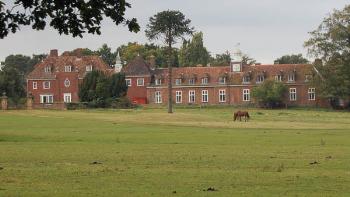Ickwell Before 1086

Ickwell Bury September 2007
The Bedfordshire Historic Environment Record [HER] lists all known prehistoric, Roman and Anglo-Saxon sites and find spots in the county. It is now on-line as part of the Heritage Gateway website. Only one prehistoric site has been found in Ickwell - a group of bronze objects from Ickwell Bury [HER 431]. These Bronze Age artefacts comprised three axes or palstaves, including one unusual type with a rib around the socket, and two possible ingots.
Two Romano-British sites have been identified. Two Roman skeletons (some sources give three) were found in Church Field, north-west of Ickwell Green in or about 1845 [HER 425]. The skeletons were accompanied by three glass vessels (only two are described), all broken, pottery vessels of Samian ware, and an iron object interpreted as a bracket for hanging a lamp from a wall. Samian ware was high status red gazed pottery made in Gaul from the 1st to mid 3rd centuries AD.
More Samian vessels were reportedly found nearby in 1881 and a letter dated 1824 mentions Roman objects found at Northill. These may have come from the same site, or nearby, suggesting occupation and cemetery use.
South-east of Ickwell are the clear cropmarks of a trapezoidal enclosure near to less distinct marks of a possible group of small irregular enclosures [HER16787]. This area was excavated as part of a pipeline construction in 2001.
The excavations uncovered a number of ditches and pits which spanned the whole Roman period. There was a significant quantity of domestic refuse in the fills which indicated that the features were on the edge of a settlement, probably located further north on the site of the trapezoidal enclosure cropmark. Several hundred metres east of these features an isolated, undated, crouched burial was found in poor condition.
The site produced three concentrations of archaeology which all seemed to follow the same pattern of starting in the mid 1st century with a high amount of features dating to the late 1st and 2nd centuries. There was then a period of minimal activity in the 3rd century which picked up in the 4th century when new features were dug and old ones cleaned out or recut.